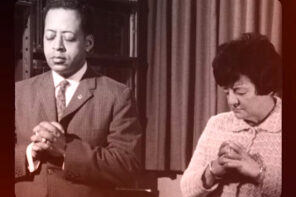Religion comforts the afflicted and afflicts the comfortable—or so we’re told. (Actually, the phrase was first coined about a newspaper.) But what happens when it comforts the afflicted precisely by afflicting them more? Say, by cosmologizing and theologizing their problems, rather than solving them? And suppose you could make a buck by doing so?
Such are the conundrums both of traditional religions and of what scholars call new religious movements or NRMs (what many refer to as “cults”). Traditional religion assuages human guilt by projecting it onto the Divine; it writes myths based on our neuroses; it answers our fears and prejudices by proposing that they are part of God’s will. NRMs are no different, really—they’re just more obvious about it.
I admit, I didn’t expect to think of any of these theological questions when I received my review copy of Kate Bornstein’s new memoir, A Queer and Pleasant Danger. I was hoping for a good read, and I got it—Bornstein is hilarious, honest, acerbic, and fearless in her writing. I was also hoping, if you’ll pardon my French, for a good genderfuck, and I got that too. Bornstein, who made her name with the transgender (as in transcending gender) classics Gender Outlaw and My Gender Workbook, not only re-confounded my ideas about gender (and I am a professional queer activist) but forced me to reexamine my assumptions about BDSM and a host of other erotic topics.
But what I didn’t know, until reading this book, was that there’s a whole other chapter to Bornstein’s story: as Al Bornstein, he was one of the most elite members of the Church of Scientology. And while several exposes of the “Church” have already appeared, A Queer and Pleasant Danger is one of the most damning, most sympathetic, and most knowledgeable.
QAPD is at least three books in one, each of which is a page-turner. The first part is a powerful, at times painful, autobiography of a transgender woman growing up before the category even existed. In some ways, LGBT-youth-memoir is a conventional narrative, but Bornstein has never been conventional and—Goddess help us—never will be. If QAPD ended at page 54, it would be a must-read for anyone interested in transgender, queer theory, or LGBT lives more generally.
But then there’s part two, on Bornstein’s twelve years in Scientology, and part three, on her eventual liberation, transition, and embrace of her kinky, post-gender, post-fame self. (Bornstein’s new book gives her status as a “cult hero” a whole new meaning.) These are also two complete books, and also indispensable. Where to begin?
Infallible but Religious
Hugh Urban’s rather tentative book, The Church of Scientology: The History of a New Religion, published last year by Princeton University Press, refuses to condemn Scientology, or to praise it [see “Scientology: All-American Religion or Aging Hoax,” RD, 11/9/11]. Instead, he investigates how a secular self-help organization remade itself into a “religion” for regulatory and tax purposes, how it convinced the IRS to treat it as such (Urban focuses on the conceptual arguments rather than the dirty tricks), and how it problematizes conventional and academic definitions of religion itself.
Taking a convincing and objective tone—sometimes too objective—Urban shows that Scientology was never intended to be a religion but only pursued what founder L. Ron Hubbard called “the religion angle” when its claims to healing ran afoul of government regulators (i.e. they didn’t work).
Bornstein makes a similar point in QAPD. Her book is, movingly, dedicated to her daughter and grandchildren, all of whom are still in the Scientology machine. Because Bornstein was thrown out of the Church, she has never met her grandchildren, and hasn’t seen her daughter since she was nine years old. Bornstein interrupts the memoir’s narrative a number of times to directly address these lost descendants, hoping against hope that they will someday read it. She knows, though, that for any of them to even contact her would brand them enemies of the Church.
And yet, Bornstein says quite clearly that in the 1970s no one in Scientology thought of it as a religion at all. Hubbard’s teachings were regarded as infallible, but not for any specifically religious or dogmatic reason. His words were valued in the same way as, say, the New Age ‘Law of Attraction’ (formerly known as New Thought): based on their supposedly demonstrable truth, not their religious authority. The devotion of Scientologists to Hubbard may have been weird, slavish, and naïve—but it wasn’t really religious.
Or was it? Scientology was intentionally designed to comfort the afflicted, just like religion does. And, just like religion, it tells absurd myths—if you still haven’t heard them, Google “Xenu” to read formerly ultra-secret church documents describing the preposterous prehistoric intergalactic battle that caused life as we know it to exist, or just watch the South Park episode about it here. The only difference is that Scientology makes a lot of money doing so. And yet, isn’t the Catholic Church still one of the richest organizations on the planet? Since when does financial success mean that an institution isn’t a religion?
Finding the Answers… He Didn’t Need
In Al Bornstein’s case, Scientology gave him all the answers he needed not to hear. (Referring to pre-transition Bornstein, I use masculine pronouns here.) His gender dysphoria, the lifelong sense of being a woman trapped in a man’s body? Well, souls (“thetans” in Scientology-ese) have no gender, so gender labels don’t matter much anyway. His need for a strong father figure? “Ron” provided that. (I have to admit, eavesdropping on Bornstein’s firsthand conversations with the science-fiction-writer-turned-omnipotent-religious-deity gave me a thrill.) And his problematic relationships to drugs and alcohol? Completing a Scientology course convinced him that these weren’t problems at all.
In other words, Scientology enabled Al Bornstein to avoid every major issue he needed to address. It gave him endless work to do, and indulged his masochistic side—which comes out with a vengeance in part three of Queer and Pleasant Danger—with frequent reprimands that both played on and fueled his sense of inadequacy.
Not to speak out of turn here, but isn’t that what religion often does as well? Doesn’t it often reinforce sexism, ethnocentrism, homophobia, germ-phobia, unresolved parental issues, violence, and fear of the unknown? Doesn’t it tell us that problems we can address—poverty, injustice, sexual inhibitions, whatever—are “God’s will” or in some other way beyond human intervention? Not always, of course, but bad religion often reinforces the very neuroses and limitations that hold human beings back… just like Scientology did for Al Bornstein.
Now, there are important differences. Bornstein was thrown out of Scientology not for his sexual deviance or some doctrinal dispute, but because he unintentionally exposed a financial scam in which money meant for the ‘Church’ went instead to Hubbard’s Swiss bank account. He was then interrogated, defamed, railroaded out of the organization, and branded a “Suppressive Person”—i.e. a heretic with whom contact is strictly forbidden and who may be opposed by any means necessary. Once again, the rhetoric of religion allows Scientology to extort, deceive, and control—but this is not really a religion, either.
There’s so much more in QAPD, but throughout it run themes of truth-telling and truth-avoidance, of ways to postpone the reality of one’s own difficult shadows, and of ways to admit and confront them. I can’t imagine the specifics of Bornstein’s dark places. Her gender evolution makes my own closet-to-light gay journey seem easy and banal, and her adventures in BDSM make my sex life look irredeemably vanilla. And I haven’t even touched on some of the book’s most compelling autobiographical material—the spiritual search, the unexpected success, the family drama.
But I can relate to her embrace of, rejection of, and refusal to fully condemn a life which ultimately didn’t serve her; a way of being which postponed that which should have been confronted, but which provided much-needed comfort along the way. And as with Bornstein’s other brilliant books, I wonder how many of my own choices may be implicated in the logic she’s uncovered.




